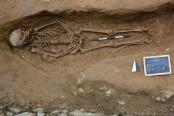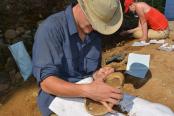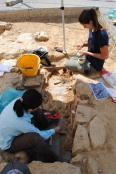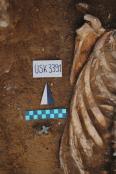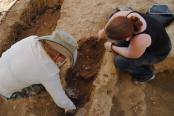CAMPAGNA 2014 |
1° SETTIMANA |
2° SETTIMANA |
3° SETTIMANA |
4° SETTIMANA |
5° SETTIMANA |
6° SETTIMANA |
7° SETTIMANA |
8° SETTIMANA |
02 LUGLIO 2014 
Resoconto della giornata di scavo
Area 2000
Nel Settore A è stata completata la documentazione e la rimozione dell'individuo Usk 2415 e del rispettivo taglio US-2414: si tratta di un uomo adulto di circa 30-40 anni di età, alto 1.56 m, con arti inferiori distesi paralleli e gli arti superiori sul bacino. Si nota una compressione delle spalle con verticalizzazione delle clavicole ad indicare la probabile presenza di una fasciatura al momento del seppellimento.
Nella porzione centro orientale è continuata l'indagine all'interno del taglio regolare, già indagato gli scorsi giorni, US-2204: subito al di sotto è stato infatti identificato un secondo taglio sepolcrale allungato con forma squadrata che è orientato Ovest Est (US -2422). All'interno è stato parzialmente esposto Usk 2423 di cui si conservano gli arti inferiori, il bacino, gli arti superiori ma non il cranio e parte delle vertebre toraciche disturbate a Ovest da due tagli indagati lo scorso anno. Dalle prime osservazioni effettuate l'individuo ha caratteristiche prettamente femminili e sembra essere giovane. Domani si procederà alla completa documentazione.
Subito a Sud è stato evidenziato un altro taglio, questa volta più irregolare ma con un riempimento ben definito caratterizzato da elementi litici di medie e piccole dimensioni e lastrine, che sarà indagato nei prossimi giorni.
Nell'allargamento è stato completamente rimosso Usk 2409 il quale presentava alcuni grani di rosario tra le mani e un gancetto bronzeo probabilmente usato per chiudere una veste.
Nell'angolo Nord Ovest due nuove sepolture sono state identificate e documentate:
US -2424 ha un orientameno Nord Sud e all'interno è stato sepolto Usk 2425 di cui è stato esposto solo il cranio in norma laterale sinistra.
US -2418 è orientato Est Ovest ed è probabilmente da collegare ad un taglio identificato due anni fa che proseguiva nell'angolo Nord Ovest dell'Area 2000: dell'individuo qui sepolto (Usk 2419), di cui sono stati esposti e rimossi gli arti inferiori privi dei piedi, era stata già esposta, documentata e rimossa la parte superiore del corpo durante la campagna del 2012. Interessante il rinvenimento di alcuni chiodi lungo il perimetro della fossa e di alcuni residui lignei al centro delle due tibie, che farebbe pensare all'uso di una tavola sotto il corpo durante la deposizione.
The burial in the southern side of Sector A was fully excavated and removed. It was determined that it was an adult male. North of that burial, located in the cut below the previously excavated juvenile skeleton, another burial orientated east to west was located. Beads were uncovered in the north-east corner, and two nails were discovered along the perimeter of the cut on the east and west sides oriented north to south. Work was begun defining another possible cut oriented east to west. In the Sector A extension the burial along the southern wall was fully removed. In the northeast corner of the extension two burials were excavated. The burial located closest to the middle of the section is oriented north to south on its right side. The burial located closest to the northern limit consisted only of lower limbs minus the feet and was fully excavated and removed. The remainder of the section was then pick-axed and cleaned in order to identify more cuts and lower the level of the site.
Area 3000
Nel Settore A continua la messa in luce del livello di riduzione US 3395, esteso in modo omogeneo al di sopra dello strato di lastre di scisto (US 3396) poste di piatto all'interno della cassa litica US 3310. Nel Settore B si è proceduto con la documentazione dell'individuo USK 3391, orientato N-S e deposto in decubito dorsale all'interno della fossa sepolcrale US - 3389. Dell'inumato, un maschio adulto in buono stato di conservazione, è stato effettuato anche il rilievo 3D. Durante la rimozione dello scheletro è stato rinvenuto un crocifisso in bronzo, collocato ad ovest dell'emitorace destro; tale oggetto devozionale si aggiunge agli altri due elementi di corredo che accompagnavano il defunto, ovvero una medaglietta votiva, collocata ad ovest del cranio ed una moneta riferibile alla fine del XVIII secolo, rinvenuta a sud dell'epifisi prossimale del femore sinistro. La posizione particolare di tale moneta sembra suggerire la possibilità che l'inumato, probabilmente sepolto con i propri abiti, sia stato posto con tale spicciolo collocato all'interno della tasca sinistra. Nella porzione centro-orientale del settore sono stati inoltre individuati i limiti di una fossa sepolcrale (US - 3285) orientata W-E, che sarà indagata nel corso della giornata di domani.
Today Area 3000 continued work on the skeleton in the northwestern part of sector B, as well as the cleaning of the reduction in the lithic coffin in sector A. In the first grave, cleaning was finished and the skeleton was removed. As the upper arm on the right side was removed, another medallion was found, this one cross shaped and about 4 cm long by 2 cm wide. It appears to have Jesus on one side, and possibly Mary or another figure on the other. All of the body except for the vertebrae was removed today. As it was removed, soil samples from around the cranium were taken to be analyzed in lab. It was also noticed that the soil of the bottom of the grave was a different color on the left side than on the right, suggesting that the left side may be the fill of another burial underneath. In the lithic coffin, all of the bones from reductions were cleaned and removed. A layer of slate was found underneath the bones, which has the possibility of being either a floor of the tomb, or the top of another grave underneath the reduction level. In addition to the continued work on these two areas, a new burial was found in the east of Sector B, near the door of the modern church. This grave is interesting because the body has blue slate on top of it, although it can’t yet be determined exactly what that means. The cranium was crushed, and one nail was found in the abdominal area. Tomorrow, this new grave will continue to be excavated, and work on the lithic coffin will also continue.
Ricostruzione fotogrammetrica tridimensionale dello skeletro USk 3391
Area 4000
Con la rimozione di US 4175 ed US 4177 sono stati messi in luce i tagli UUSS -4182, -4180 e -4181. Il primo è risultato riempito dalla suddetta US 4177, la quale, una volta rimossa, ha permesso di mettere in luce US 4178, strato argillo-limoso in cui sono state rinvenute sia ossa sparse che in connessione. I tagli US -4180 e US -4181 sono stati messi in luce con la rimozione di US 4175, la quale sembrava, inizialmente, costituire il riempimento di un unico taglio orientato N-S. Al momento attuale, date forma e dimensioni, le due US negative sembrerebbero costituire due contesti sepolcrali. Le indagini dei prossimi giorni permetteranno di confermare o meno questa ipotesi.
Today in Area 4000 at field school Pozzeveri we continue excavating context 4175 and 4177 found more pottery and bone including multiple femur fragments, tibia and medieval glass. We completed the Context Sheets in order to document the state and levels of each area. We took pictures and measured the different heights of each contexts so we could continue to uncover the fill context 4175 and 4177. Tomorrow we will determine whether the context 4177 fill is a burial or of a cemetery context.
Area 5000
Dopo la rimozione di US 5007, uno strato a matrice limo-sabbiosa situato nella zona meridionale dell'area, è stata messa in luce un'ulteriore porzione dello strato composto da lastre litiche e laterizi disposti orizzontalmente sul terreno (US 5023). E' emerso inoltre un nuovo strato a matrice argillosa nella porzione meridionale dell'area, mentre a est compare il riempimento della fossa di spoliazione del muro interno del chiostro, già individuato nella scorsa campagna di scavo nell'area 4000.
Today in area 5000 we started the day with a clearing of the central region. This consisted of using pick axes to pull up large pieces of brick, and troweling to uncover the underlying slate layer. A number of features were uncovered, including a north to south running context, along the eastern wall of the area. The soil consisted of a sandy texture, and due to the shape and orientation it could possibly be the cut and fill extending from the wall feature found in area 4000. Evidence of a potential trench on the west side was uncovered, and one of the pits was thought to be a potential post hole from the 18th-19th century. After thoroughly cleaning all of the newly uncovered area with trowels and brushes, we proceeded to take photographs to document the new layer. The focus for the rest of the week will be to remove designated slate contexts, to determine if anything lays underneath.











